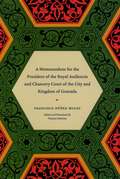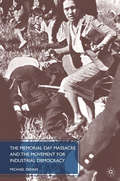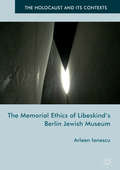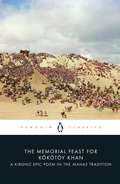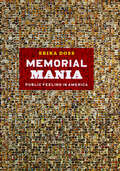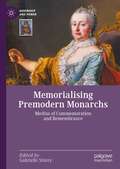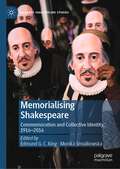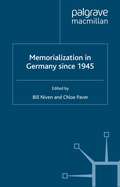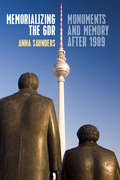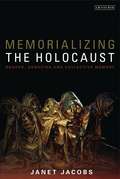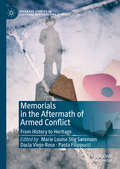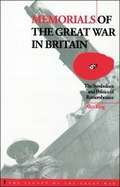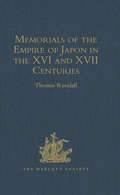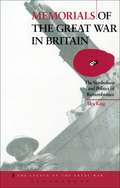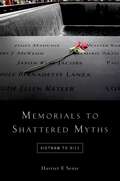- Table View
- List View
A Memorandum for the President of the Royal Audiencia and Chancery Court of the City and Kingdom of Granada
by Francisco Núñez MuleyConquered in 1492 and colonized by invading Castilians, the city and kingdom of Granada faced radical changes imposed by its occupiers throughout the first half of the sixteenth century—including the forced conversion of its native Muslim population. Written by Francisco Núñez Muley, one of many coerced Christian converts, this extraordinary letter lodges a clear-sighted, impassioned protest against the unreasonable and strongly assimilationist laws that required all converted Muslims in Granada to dress, speak, eat, marry, celebrate festivals, and be buried exactly as the Castilian settler population did. Now available in its first English translation, Núñez Muley’s account is an invaluable example of how Spain’s former Muslims made active use of the written word to challenge and openly resist the progressively intolerant policies of the Spanish Crown. Timely and resonant—given current debates concerning Islam, minorities, and cultural and linguistic assimilation—this edition provides scholars in a range of fields with a vivid and early example of resistance in the face of oppression.
A Memorandum for the President of the Royal Audiencia and Chancery Court of the City and Kingdom of Granada
by Francisco Núñez MuleyConquered in 1492 and colonized by invading Castilians, the city and kingdom of Granada faced radical changes imposed by its occupiers throughout the first half of the sixteenth century—including the forced conversion of its native Muslim population. Written by Francisco Núñez Muley, one of many coerced Christian converts, this extraordinary letter lodges a clear-sighted, impassioned protest against the unreasonable and strongly assimilationist laws that required all converted Muslims in Granada to dress, speak, eat, marry, celebrate festivals, and be buried exactly as the Castilian settler population did. Now available in its first English translation, Núñez Muley’s account is an invaluable example of how Spain’s former Muslims made active use of the written word to challenge and openly resist the progressively intolerant policies of the Spanish Crown. Timely and resonant—given current debates concerning Islam, minorities, and cultural and linguistic assimilation—this edition provides scholars in a range of fields with a vivid and early example of resistance in the face of oppression.
A Memorandum for the President of the Royal Audiencia and Chancery Court of the City and Kingdom of Granada
by Francisco Núñez MuleyConquered in 1492 and colonized by invading Castilians, the city and kingdom of Granada faced radical changes imposed by its occupiers throughout the first half of the sixteenth century—including the forced conversion of its native Muslim population. Written by Francisco Núñez Muley, one of many coerced Christian converts, this extraordinary letter lodges a clear-sighted, impassioned protest against the unreasonable and strongly assimilationist laws that required all converted Muslims in Granada to dress, speak, eat, marry, celebrate festivals, and be buried exactly as the Castilian settler population did. Now available in its first English translation, Núñez Muley’s account is an invaluable example of how Spain’s former Muslims made active use of the written word to challenge and openly resist the progressively intolerant policies of the Spanish Crown. Timely and resonant—given current debates concerning Islam, minorities, and cultural and linguistic assimilation—this edition provides scholars in a range of fields with a vivid and early example of resistance in the face of oppression.
The Memorial Day Massacre and the Movement for Industrial Democracy
by M. DennisThis book explores one of the most dramatic and scandalous events in the movement for American democratic reform. Dubbed the Memorial Day Massacre, it saw Chicago police shoot and kill ten demonstrators and beat more than one hundred others as they tried to form a mass picket line at the Republic Steel Plant in South Chicago.
The Memorial Ethics of Libeskind's Berlin Jewish Museum (The Holocaust and its Contexts)
by Arleen IonescuThis book is a detailed critical study of Libeskind’s Berlin Jewish Museum in its historical, architectural and philosophical context. Emphasizing how the Holocaust changed our perception of history, memory, witnessing and representation, it develops the notion of ‘memorial ethics’ to explore the Museum’s difference from more conventional post-World War Two commemorative sites. The main focus is on the Museum as an experience of the materiality of trauma which engages the visitor in a performative duty to remember. Arleen Ionescu builds on Levinas’s idea of ‘ethics as optics’ to show how Libeskind’s Museum becomes a testimony to the unpresentable Other. Ionescu also extends the Museum’s experiential dimension by proposing her own subjective walk through Libeskind’s space reimagined as a ‘literary museum’. Featuring reflections on texts by Beckett, Celan, Derrida, Kafka, Blanchot, Wiesel and Selma Meerbaum-Eisinger (Celan’s cousin), this virtual tour concludes with a brief account of Libeskind’s analogous ‘healing project’ for Ground Zero.
The Memorial Feast for Kökötöy Khan: A Kirghiz Epic Poem in the Manas Tradition
by Saghïmbay Orozbaq uuluThis great Central Asian epic, passed down through generations and now brought to life in a new translation, carries the reader into a world of nomads, warriors and horselords'I am a steel-fanged lion, a dragon ready to pounce, a mighty poplar with golden branches rising up to the sky'The bard Saghïmbay Orozbaq uulu composed his oral telling of the great Central Asian Manas epic in the early twentieth century, although it draws on far older sources. This vivid episode from his narrative tells the bravura story of an uncertain new khan, Boqmurun, who holds a great feast to commemorate his predecessor, Kökötöy. From east and west, warriors and their turbulent retinues come to compete in horse races, jousting and wrestling, and soon insults are hurled and scores settled violently. Yet none can beat the supreme hero, the mighty, truculent Manas. By turns earthy, stirring, bombastic and funny, Saghïmbay's work stands as a monument to the oral culture of a nomadic people.Daniel Prior's landmark translation includes a 'How to Read the Epic' section, commentary, maps and illustrations.Composed in oral performance by Saghïmbay Orozbaq uulu Translated by Daniel Prior
Memorial Mania: Public Feeling in America
by Erika DossIn the past few decades, thousands of new memorials to executed witches, victims of terrorism, and dead astronauts, along with those that pay tribute to civil rights, organ donors, and the end of Communism have dotted the American landscape. Equally ubiquitous, though until now less the subject of serious inquiry, are temporary memorials: spontaneous offerings of flowers and candles that materialize at sites of tragic and traumatic death. In Memorial Mania, Erika Doss argues that these memorials underscore our obsession with issues of memory and history, and the urgent desire to express—and claim—those issues in visibly public contexts. Doss shows how this desire to memorialize the past disposes itself to individual anniversaries and personal grievances, to stories of tragedy and trauma, and to the social and political agendas of diverse numbers of Americans. By offering a framework for understanding these sites, Doss engages the larger issues behind our culture of commemoration. Driven by heated struggles over identity and the politics of representation, Memorial Mania is a testament to the fevered pitch of public feelings in America today.
Memorial Mania: Public Feeling in America
by Erika DossIn the past few decades, thousands of new memorials to executed witches, victims of terrorism, and dead astronauts, along with those that pay tribute to civil rights, organ donors, and the end of Communism have dotted the American landscape. Equally ubiquitous, though until now less the subject of serious inquiry, are temporary memorials: spontaneous offerings of flowers and candles that materialize at sites of tragic and traumatic death. In Memorial Mania, Erika Doss argues that these memorials underscore our obsession with issues of memory and history, and the urgent desire to express—and claim—those issues in visibly public contexts. Doss shows how this desire to memorialize the past disposes itself to individual anniversaries and personal grievances, to stories of tragedy and trauma, and to the social and political agendas of diverse numbers of Americans. By offering a framework for understanding these sites, Doss engages the larger issues behind our culture of commemoration. Driven by heated struggles over identity and the politics of representation, Memorial Mania is a testament to the fevered pitch of public feelings in America today.
Memorial Mania: Public Feeling in America
by Erika DossIn the past few decades, thousands of new memorials to executed witches, victims of terrorism, and dead astronauts, along with those that pay tribute to civil rights, organ donors, and the end of Communism have dotted the American landscape. Equally ubiquitous, though until now less the subject of serious inquiry, are temporary memorials: spontaneous offerings of flowers and candles that materialize at sites of tragic and traumatic death. In Memorial Mania, Erika Doss argues that these memorials underscore our obsession with issues of memory and history, and the urgent desire to express—and claim—those issues in visibly public contexts. Doss shows how this desire to memorialize the past disposes itself to individual anniversaries and personal grievances, to stories of tragedy and trauma, and to the social and political agendas of diverse numbers of Americans. By offering a framework for understanding these sites, Doss engages the larger issues behind our culture of commemoration. Driven by heated struggles over identity and the politics of representation, Memorial Mania is a testament to the fevered pitch of public feelings in America today.
Memorial Mania: Public Feeling in America
by Erika DossIn the past few decades, thousands of new memorials to executed witches, victims of terrorism, and dead astronauts, along with those that pay tribute to civil rights, organ donors, and the end of Communism have dotted the American landscape. Equally ubiquitous, though until now less the subject of serious inquiry, are temporary memorials: spontaneous offerings of flowers and candles that materialize at sites of tragic and traumatic death. In Memorial Mania, Erika Doss argues that these memorials underscore our obsession with issues of memory and history, and the urgent desire to express—and claim—those issues in visibly public contexts. Doss shows how this desire to memorialize the past disposes itself to individual anniversaries and personal grievances, to stories of tragedy and trauma, and to the social and political agendas of diverse numbers of Americans. By offering a framework for understanding these sites, Doss engages the larger issues behind our culture of commemoration. Driven by heated struggles over identity and the politics of representation, Memorial Mania is a testament to the fevered pitch of public feelings in America today.
Memorial Mania: Public Feeling in America
by Erika DossIn the past few decades, thousands of new memorials to executed witches, victims of terrorism, and dead astronauts, along with those that pay tribute to civil rights, organ donors, and the end of Communism have dotted the American landscape. Equally ubiquitous, though until now less the subject of serious inquiry, are temporary memorials: spontaneous offerings of flowers and candles that materialize at sites of tragic and traumatic death. In Memorial Mania, Erika Doss argues that these memorials underscore our obsession with issues of memory and history, and the urgent desire to express—and claim—those issues in visibly public contexts. Doss shows how this desire to memorialize the past disposes itself to individual anniversaries and personal grievances, to stories of tragedy and trauma, and to the social and political agendas of diverse numbers of Americans. By offering a framework for understanding these sites, Doss engages the larger issues behind our culture of commemoration. Driven by heated struggles over identity and the politics of representation, Memorial Mania is a testament to the fevered pitch of public feelings in America today.
Memorial Mania: Public Feeling in America
by Erika DossIn the past few decades, thousands of new memorials to executed witches, victims of terrorism, and dead astronauts, along with those that pay tribute to civil rights, organ donors, and the end of Communism have dotted the American landscape. Equally ubiquitous, though until now less the subject of serious inquiry, are temporary memorials: spontaneous offerings of flowers and candles that materialize at sites of tragic and traumatic death. In Memorial Mania, Erika Doss argues that these memorials underscore our obsession with issues of memory and history, and the urgent desire to express—and claim—those issues in visibly public contexts. Doss shows how this desire to memorialize the past disposes itself to individual anniversaries and personal grievances, to stories of tragedy and trauma, and to the social and political agendas of diverse numbers of Americans. By offering a framework for understanding these sites, Doss engages the larger issues behind our culture of commemoration. Driven by heated struggles over identity and the politics of representation, Memorial Mania is a testament to the fevered pitch of public feelings in America today.
Memorialising Premodern Monarchs: Medias of Commemoration and Remembrance (Queenship and Power)
by Gabrielle StoreyThis book examines the legacies and depictions of monarchs in an international context, focusing on both self-representation and commemoration by others. Spanning ancient India through to eighteenth-century Russia, this volume offers several case studies to demonstrate trends and patterns in how different societies chose to commemorate and remember their rulers in a variety of mediums. Contributions highlight several lesser known rulers, alongside more famous ones such as Henry VIII of England, to develop a deeper understanding of how memory and monarchy functioned when drawn together. Memorialising Premodern Monarchs brings to the fore the importance of memory and memorialisation when considering the legacies and records of past rulers and their societies, and allows a deeper reflection on how these rulers live on through the historical record and popular culture.
Memorialising Shakespeare: Commemoration and Collective Identity, 1916–2016 (Palgrave Shakespeare Studies)
by Edmund G. C. King Monika SmialkowskaThis book is the first comprehensive account of global Shakespeare commemoration in the period between 1916 and 2016. Combining historical analysis with insights into current practice, Memorialising Shakespeare covers Shakespeare commemoration in China, Ukraine, Egypt, and France, as well as Great Britain and the United States. Chapter authors discuss a broad range of commemorative activities—from pageants, dance, dramatic performances, and sculpture, to conferences, exhibitions, and more private acts of engagement, such as reading and diary writing. Themes covered include Shakespeare’s role in the formation of cultural memory and national and global identities, as well as Shakespeare’s relationship to decolonisation and race. A significant feature of the book is the inclusion of chapters from organisers of recent Shakespeare commemoration events, reflecting on their own practice. Together, the chapters in Memorialising Shakespeare show what has been at stake when communities, identity groups, and institutions have come together to commemorate Shakespeare.
Memorialization in Germany since 1945
by B. Niven C. PaverDifficult Pasts provides a wide-ranging discussion of contemporary Germany's rich memorial landscape. It discusses the many memorials to German losses during the Second World War, to the victims of National Socialism and to those of GDR socialism. With up-to-date coverage of many less well-known memorials as well as the most publicised ones.
Memorializing the GDR: Monuments and Memory after 1989
by Anna SaundersSince unification, eastern Germany has witnessed a rapidly changing memorial landscape, as the fate of former socialist monuments has been hotly debated and new commemorative projects have met with fierce controversy. Memorializing the GDR provides the first in-depth study of this contested arena of public memory, investigating the individuals and groups devoted to the creation or destruction of memorials as well as their broader aesthetic, political, and historical contexts. Emphasizing the interrelationship of built environment, memory and identity, it brings to light the conflicting memories of recent German history, as well as the nuances of national and regional constructions of identity.
Memorializing the Holocaust: Gender, Genocide and Collective Memory
by Janet JacobsHow do collective memories of histories of violence and trauma in war and genocide come to be created? Janet Jacobs offers new understandings of this important issue in her examination of the representation of gender in the memorial culture of Holocaust monuments and museums, from synagogue memorials and other historical places of Jewish life and culture, to the geographies of Auschwitz, Majdanek and Ravensbrück.Jacobs travelled to Holocaust sites across Europe to explore representations of women. She reveals how these memorial cultures construct masculinity and femininity, explores gender and religious memory, and looks at the Holocaust's effect on stereotyping on grounds of race or gender. She also uncovers the wider ways in which images of violence against women have become universal symbols of mass trauma and genocide. This feminist analysis of Holocaust memorialization brings together gender and collective memory with the geographies of genocide to fill a significant gap in our understanding of genocide and national remembrance.
Memorials in the Aftermath of Armed Conflict: From History to Heritage (Palgrave Studies in Cultural Heritage and Conflict)
by Marie Louise Stig Sørensen Dacia Viejo-Rose Paola FilippucciThrough case studies from Europe and Russia, this volume analyses memorials as a means for the present to make claims on the past in the aftermath of armed conflict. The central contention is that memorials are not backward-looking, inert reminders of past events, but instead active triggers of personal and shared emotion, that are inescapably political, bound up with how societies reconstruct their present and future as they negotiate their way out of (and sometimes back into) conflict. A central aim of the book is to highlight and illustrate the cultural and ethical complexity of memorials, as focal points for a tension between the notion of memory as truth, and the practice of memory as negotiable. By adopting a relatively bounded temporal and spatial scope, the volume seeks to move beyond the established focus on national traditions, to reveal cultural commonalities and shared influences in the memorial forms and practices of individual regions and of particular conflicts.
Memorials Of The Great War In Britain: The Symbolism And Politics Of Remembrance (PDF)
by Alex KingTaking as its focus memorials of the First World War in Britain, this book brings a fresh approach to the study of public symbols by exploring how different motives for commemorating the dead were reconciled through the processes of local politics to create a widely valued form of collective expression. It examines how the memorials were produced, what was said about them, how support for them was mobilized and behaviour around them regulated. These memorials were the sites of contested, multiple and ambiguous meanings, yet out of them a united public observance was created. The author argues that this was possible because the interpretation of them as symbols was part of a creative process in which new meanings for traditional forms of memorial were established and circulated. The memorials not only symbolized emotional responses to the war, but also ambitions for the post-war era. Contemporaries adopted new ways of thinking about largely traditional forms of memorial to fit the uncertain social and political climate of the inter-war years. This book represents a significant contribution to the study of material culture and memory, as well as to the social and cultural history of modern warfare.
Memorials of the Empire of Japon in the XVI and XVII Centuries (Hakluyt Society, First Series)
by Thomas RundallThe volume includes documents, including a description of Japan in the sixteenth century from Harleian mss. 6249, and the letters of William Adams, 1611-17, edited and annotated, and a summary of a narrative by His Excellancy Don Rodrigo de Vivero y Velasco of his residence in the empire, 1608-1610. The supplementary material includes the 1849 annual report. This is a new print-on-demand hardback edition of the volume first published in 1850.
Memorials of the Empire of Japon in the XVI and XVII Centuries: In The Xvi And Xvii Centuries (Hakluyt Society, First Series)
by Thomas RundallThe volume includes documents, including a description of Japan in the sixteenth century from Harleian mss. 6249, and the letters of William Adams, 1611-17, edited and annotated, and a summary of a narrative by His Excellancy Don Rodrigo de Vivero y Velasco of his residence in the empire, 1608-1610. The supplementary material includes the 1849 annual report. This is a new print-on-demand hardback edition of the volume first published in 1850.
Memorials of the Great War in Britain: The Symbolism and Politics of Remembrance (The Legacy of the Great War)
by Alex KingTaking as its focus memorials of the First World War in Britain, this book brings a fresh approach to the study of public symbols by exploring how different motives for commemorating the dead were reconciled through the processes of local politics to create a widely valued form of collective expression. It examines how the memorials were produced, what was said about them, how support for them was mobilized and behaviour around them regulated. These memorials were the sites of contested, multiple and ambiguous meanings, yet out of them a united public observance was created. The author argues that this was possible because the interpretation of them as symbols was part of a creative process in which new meanings for traditional forms of memorial were established and circulated. The memorials not only symbolized emotional responses to the war, but also ambitions for the post-war era. Contemporaries adopted new ways of thinking about largely traditional forms of memorial to fit the uncertain social and political climate of the inter-war years.This book represents a significant contribution to the study of material culture and memory, as well as to the social and cultural history of modern warfare.
Memorials of the Great War in Britain: The Symbolism and Politics of Remembrance (The\legacy Of The Great War Ser. #9)
by Alex KingTaking as its focus memorials of the First World War in Britain, this book brings a fresh approach to the study of public symbols by exploring how different motives for commemorating the dead were reconciled through the processes of local politics to create a widely valued form of collective expression. It examines how the memorials were produced, what was said about them, how support for them was mobilized and behaviour around them regulated. These memorials were the sites of contested, multiple and ambiguous meanings, yet out of them a united public observance was created. The author argues that this was possible because the interpretation of them as symbols was part of a creative process in which new meanings for traditional forms of memorial were established and circulated. The memorials not only symbolized emotional responses to the war, but also ambitions for the post-war era. Contemporaries adopted new ways of thinking about largely traditional forms of memorial to fit the uncertain social and political climate of the inter-war years.This book represents a significant contribution to the study of material culture and memory, as well as to the social and cultural history of modern warfare.
Memorials to Shattered Myths: Vietnam to 9/11
by Harriet F. SenieMemorials to Shattered Myths: Vietnam to 9/11 traces the evolution and consequences of a new hybrid paradigm, which grants a heroic status to victims of national tragedies, and by extension to their families, thereby creating a class of privileged participants in the permanent memorial process. Harriet F. Senie suggests that instead the victims' families be able to determine the nature of an interim memorial, one that addresses their needs in the critical time between the murder of their loved ones and the completion of the permanent memorial. She also observes that the memorials discussed herein are inadvertently based on strategies of diversion and denial that direct our attention away from actual events, and reframe tragedy as secular or religious triumph. In doing so, they camouflage history, and seen as an aggregate, they define a nation of victims, exactly the concept they and their accompanying celebratory narratives were apparently created to obscure.
MEMORIALS TO SHATTERED MYTHS C: Vietnam to 9/11
by Harriet F. SenieMemorials to Shattered Myths: Vietnam to 9/11 traces the evolution and consequences of a new hybrid paradigm, which grants a heroic status to victims of national tragedies, and by extension to their families, thereby creating a class of privileged participants in the permanent memorial process. Harriet F. Senie suggests that instead the victims' families be able to determine the nature of an interim memorial, one that addresses their needs in the critical time between the murder of their loved ones and the completion of the permanent memorial. She also observes that the memorials discussed herein are inadvertently based on strategies of diversion and denial that direct our attention away from actual events, and reframe tragedy as secular or religious triumph. In doing so, they camouflage history, and seen as an aggregate, they define a nation of victims, exactly the concept they and their accompanying celebratory narratives were apparently created to obscure.
